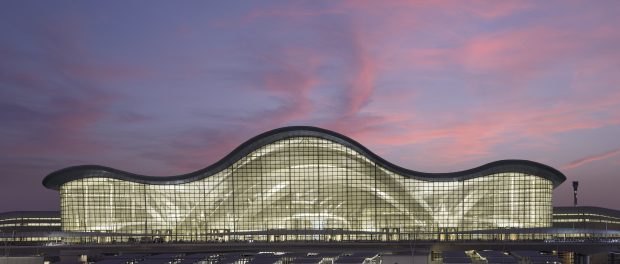Designing Beyond Borders: Why UK Architecture Firms Should Look to the Middle East for Growth
 KPF Zayed International Airport ©Victor Romero
KPF Zayed International Airport ©Victor Romero
The Middle East has emerged as a dynamic landscape for architecture, offering both challenges and opportunities for global design firms.
With rapid urbanisation, ambitious megaprojects, and a growing emphasis on sustainable development, the region is attracting architects eager to leave their mark. Industry leaders from Carter Hones Associates (CHA) (Middle East based) and London based architecture firms BDP, Grimshaw, and Kohn Pedersen Fox (KPF) share their insights on what makes the Middle East a promising market and how architects can succeed in this evolving environment.
The Current Landscape in the UK
UK architecture firms are facing an increasingly challenging domestic market, with slower economic growth, tighter margins, and fewer large-scale projects. As a result, many firms are looking to international markets for new opportunities.
Nick Fairham, Chief Executive at BDP, notes: “BDP has been invested in the Middle East for more than 15 years, with our Abu Dhabi studio central to our global growth strategy. As a truly international practice, we are cognisant of the impact of global economic fluctuations, but our commitment to the MENA region remains strong.”

© Roland Halbe, Qasr Al Hosn, Abu Dhabi
Opportunities in the Middle East
Saudi Arabia and the UAE are at the forefront of a construction boom driven by large-scale, cutting-edge developments. Saudi Arabia’s Vision 2030 and transformative projects such as NEOM, The Red Sea Project, and other major urban expansion initiatives present significant opportunities for architectural firms. These projects go beyond traditional city-building; they represent a strategic repositioning of the region’s economies on the global stage.
The demand for innovative and sustainable design solutions is growing rapidly. The Middle East’s extreme climate conditions, coupled with government-led sustainability initiatives, are driving the need for smart urban planning and green architecture. The UK’s sustainability progress has made it the top service providers to the Middle East region, closely followed by the US, Germany, France and Japan.
Craig Carter Founder & Managing Director at CHA, emphasises the importance of local expertise: “Understanding regional regulations, cultural nuances, and on-the-ground logistics is critical. Clients expect rapid, informed decision-making and realistic delivery time frames that align with their vision while adhering to local standards.”

© Nick Caville
Success Stories: UK Firms Thriving in the Middle East
UK-based firms have successfully executed some of the most high-profile projects in the Middle East, reinforcing the region’s potential as a key market for architectural growth.
Kohn Pedersen Fox (KPF) has made a lasting impact with its work on Zayed International Airport’s new Terminal A in Abu Dhabi.
James von Klemperer, President of KPF, describes it as a landmark project: “Zayed International Airport’s new Terminal A is a civic landmark for the emirate and a gateway for the world, connecting East and West on a global scale. The airport’s design was conceived and executed entirely by KPF to deliver an unrivalled travel experience.”
Another notable success is Grimshaw’s work on Terra: The Sustainability Pavilion at Expo 2020 Dubai, a project that set a new benchmark for sustainable architecture in the region.
Keith Brewis, Partner at Grimshaw, explains: “The design ambitions—net zero in water and energy—were incredibly high, particularly in the demanding climate. Our experience across the region, including the Oman Botanic Garden, has reinforced the importance of a purpose-led approach to design.”
Key Benefits for UK Firms
Nathan Hones, COO & Parter, CHA outlines the key benefits for UK Firms looking to expand internationally:
- Larger Budgets & Long-Term Projects: Megaprojects and large-scale urban development’s provide financial stability and long-term engagement.
- Global Recognition: Working on high-profile projects enhances international credibility and opens doors to further opportunities.
- Innovation & Collaboration: Exposure to cutting-edge design challenges fosters creativity and encourages collaboration with regional and global experts.
- Sustainability Leadership: The region’s focus on net-zero targets aligns with UK firms’ expertise in sustainable and regenerative design.

Yas Marina Pit and Paddock Expansion, Abu Dhabi, © Gabrielle Tester
How to Break into the Market
For UK firms considering expansion into the Middle East, strategic planning is essential. Key steps include:
- Building Local Partnerships: Collaborating with regional firms helps navigate local regulations and cultural considerations.
- Understanding Regulatory Environments: Each country has its own construction codes and compliance requirements.
- Tailoring Designs to Cultural Contexts: Sensitivity to cultural and religious factors is crucial for successful project execution.
- Leveraging Design Management Expertise: Local firms like CHA play a pivotal role in helping UK firms manage projects efficiently in the region.
Nick Fairham, Chief Executive at BDP, highlights the need for adaptability: “We understand that success in the Middle East relies on strong business relationships, cultural awareness, and a highly responsive approach. Clients value efficiency, with rapid design and construction turnaround times being a crucial differentiator. Sensitivity to cultural and religious contexts is essential, not only in design but in the way a firm conducts business.”

© Victor Romero
Future Outlook
As the Middle East continues to invest heavily in its built environment, UK firms are well-positioned to play a pivotal role in shaping the region’s future. With an emphasis on sustainable cities, technological advancements, and cultural preservation, the opportunities for architects are vast.
Keith Brewis of Grimshaw adds: “Collaboration is critical when entering any new market, and in the Middle East, it’s no different. Design is a universal language, but it must be contextually relevant and integrated within the region’s social and cultural fabric.”
With the right strategy, UK firms can seize these opportunities and contribute meaningfully to a region that is redefining modern architecture. The time to expand is now.
